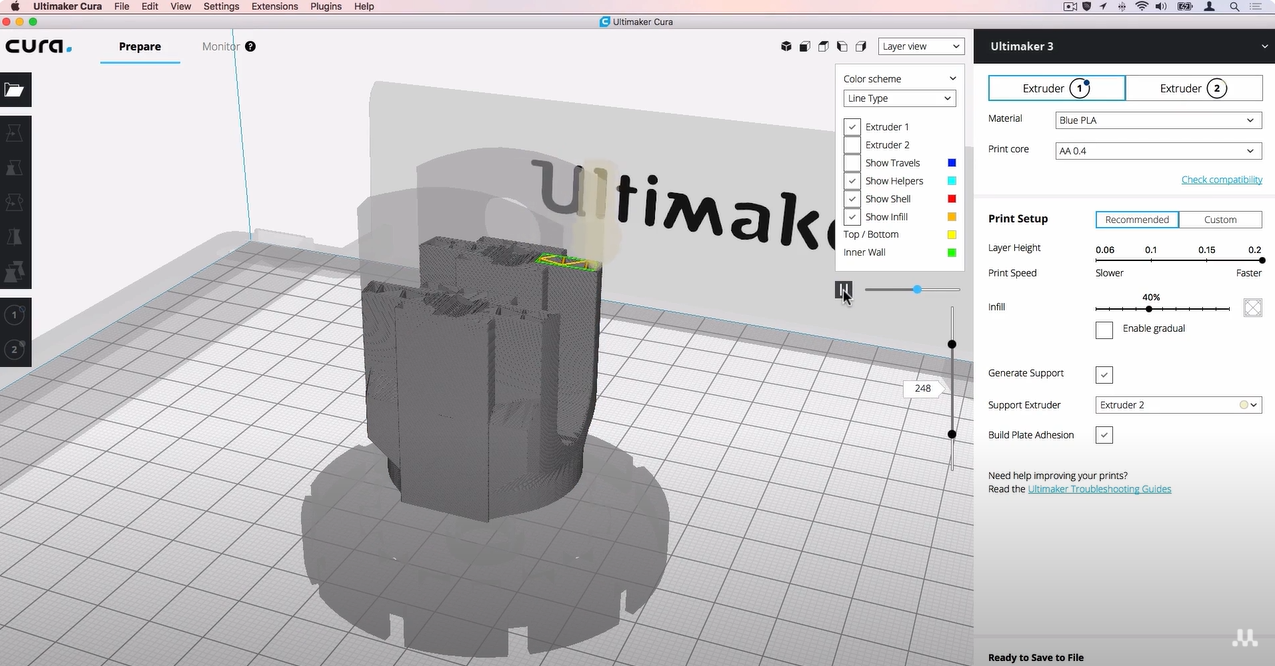Download Cura Slicer – A State-of-the-art slicer app to prepare your 3D models for your 3D printer.
UltiMaker Cura comes with hundreds of settings & community-managed print profiles, Ultimaker Cura is sure to lead your next project to a success.
Cura is an open-source 3D printing slicer software developed by Ultimaker. It is used to prepare digital 3D models for printing by converting them into instructions that a 3D printer can understand, often referred to as G-code. Cura takes a 3D model file, typically in formats like STL, OBJ, or 3MF, and slices it into many horizontal layers to create a path that the 3D printer will follow to produce the physical object.
What is UltiMaker Cura / Cura Slicer ?
UltiMaker Cura is a widely used, open-source 3D printing software developed by UltiMaker, formerly known as Ultimaker. It serves as a slicing application, which means it takes 3D models (typically in STL, OBJ, or 3MF formats) and converts them into a format that a 3D printer can understand, known as G-code. G-code contains the specific instructions that guide the printer on how to create an object layer by layer.
Slicers are complex applications. They can take a 3D model of any shape or size and calculate a 3D printing strategy that will faithfully reproduce the model in the physical world. Slicers also do other things: they can generate patterns that fill a model’s interior geometry, so it has extra strength and rigidity. They can also generate support structures for model overhangs, so you get better 3D printing results. There’s a lot more they can do, which we will explore in detail below. While slicers are complex applications, a good slicer will strike a balance between complexity and ease of use.

The software is highly popular due to its user-friendly interface, extensive customization options, and robust compatibility with a wide range of 3D printers, not just UltiMaker-branded models. UltiMaker Cura simplifies the often complex process of 3D printing, making it accessible for both beginners and experienced users alike.
Cura stands out because of its balance between ease of use and powerful customization. It’s a great tool for hobbyists, educators, and professionals who need reliable, high-quality 3D prints. The software is also continually updated by an active community and the UltiMaker team, ensuring ongoing improvements and compatibility with new hardware.
Key Features
Download Cura Slicer
How to Install Cura Slicer?
Here is a step-by-step guide on how to install Ultimaker Cura for your 3D printer:
For Windows:
- Double-click the downloaded
.exefile. - Follow the on-screen prompts by selecting “Next” through the setup wizard. You may need to agree to the licensing agreement.
- Choose a destination folder for Cura or leave it set to default.
- Cura will install necessary components, including file associations for 3D printing file types like
.STLand.3MF. - After installation, make sure the “Run Ultimaker Cura” box is checked, then click “Finish.”
For macOS:
- Open the
.dmgfile you downloaded. - Drag the Cura icon into your Applications folder.
- After installation, open Cura from the Applications folder.
For Linux:
- Download the appropriate AppImage file.
- Make the file executable by running the command: (Bash)
chmod +x Ultimaker_Cura-<version>.AppImage - Run the AppImage by double-clicking or running the command: (php)
./Ultimaker_Cura-<version>.AppImage
Getting started
After installation, Cura will automatically guide you through a setup wizard where you will need to add your printer and configure it.
Step 1: Adding Your Printer
Cura supports a wide range of 3D printers, including Ultimaker and non-Ultimaker models. Here’s how to set up your printer:
- Open Cura and click “Add a Printer” during the initial setup.
- If you’re using a non-networked printer, you’ll be prompted to select your printer from a list of manufacturers or add a custom profile if your printer isn’t listed.
- You can also manually set parameters like the build volume and nozzle size to match your specific 3D printer model.
Step 2: Understanding Cura’s User Interface
Cura’s user interface (UI) is clean and relatively straightforward, though it offers powerful tools for users. The workspace is divided into several key sections:
- Toolbar: Located on the left, this allows you to load models, adjust their scale, position, and orientation on the virtual print bed.
- Settings Pane: On the right side, you’ll find your print settings. Beginners can use the “Recommended” mode, which offers simple settings for quick prints. As you grow more comfortable, switch to “Custom” mode for more detailed control over parameters like infill density, support structures, and layer heights.
Step 3: Importing and Slicing a Model
Once your printer is set up, you can import your 3D model:
- Supported File Formats: Cura accepts
.STL,.OBJ, and.3MFfiles. Simply drag and drop your file into the workspace or click the “Open File” button. - Positioning the Model: Use the scaling, rotating, and positioning tools to ensure your model fits within the print bed and is oriented optimally. Rotating your model might reduce the need for supports, saving you material and time.
Step 4: Configuring Basic Print Settings
For beginners, Cura offers preset profiles to simplify the slicing process. Here are a few common settings you’ll want to familiarize yourself with:
- Layer Height: The thickness of each printed layer, which directly affects the print’s resolution and time. A lower layer height (e.g., 0.1mm) results in higher resolution but takes longer, while a higher layer height (e.g., 0.3mm) prints faster but at lower quality.
- Infill Density: Controls how solid the print will be. For stronger models, set a higher infill percentage (e.g., 50%), while for lightweight or decorative prints, lower values (10-20%) suffice.
- Supports and Adhesion: Cura automatically generates supports if your model has overhangs. You can also enable build plate adhesion options like skirts, brims, or rafts to help your model adhere to the print bed during printing.
Step 5: Slicing and Exporting G-code
Once you’ve adjusted your model and configured your print settings, it’s time to slice the model:
- Click “Slice”: Cura will process the model and convert it into G-code, the instructions your 3D printer needs to execute the print. You’ll see a preview of the model, along with estimated print time and material usage.
- Exporting G-code: You can save the G-code file to an SD card or USB stick for transfer to your printer, or send the file directly if using a networked printer.
Step 6: Advanced Settings and Customization
As you become more comfortable with Cura, you can explore its advanced settings:
- Custom Profiles: Cura allows you to create and save custom print profiles tailored to different materials, nozzle sizes, or specific print quality needs.
- Plugins and Add-ons: Cura’s open-source ecosystem includes many plugins. For example, CAD software users can import directly into Cura using plugins for SOLIDWORKS or AutoCAD.
- Multi-Material Printing: If you have a dual-extrusion printer, Cura supports advanced features like printing with two materials or colors in a single model.
Step 7: Troubleshooting and Fine-Tuning
Cura’s community support is extensive, and you’ll likely find solutions to common issues in forums or tutorials:
- First Layer Adhesion: If your prints aren’t sticking to the bed, consider increasing the initial layer height or adding a brim to improve adhesion.
- Stringing and Blobbing: These are common issues with temperature control. Reducing print temperatures or adjusting retraction settings can often solve these problems.
Final Thoughts: Mastering Cura
Cura is a powerful tool that grows with you. From simple settings that get you printing in minutes to advanced configurations for precision projects, it’s versatile enough to meet your needs at every stage of your 3D printing journey. Keep experimenting, and don’t hesitate to explore the extensive community for tips, tricks, and new plugins that can enhance your experience.
By following this guide, you’ll be ready to take your first steps in 3D printing using Cura, equipped with the knowledge to tackle future challenges confidently!





